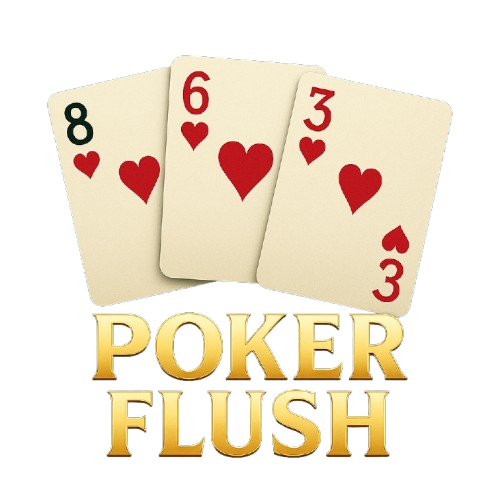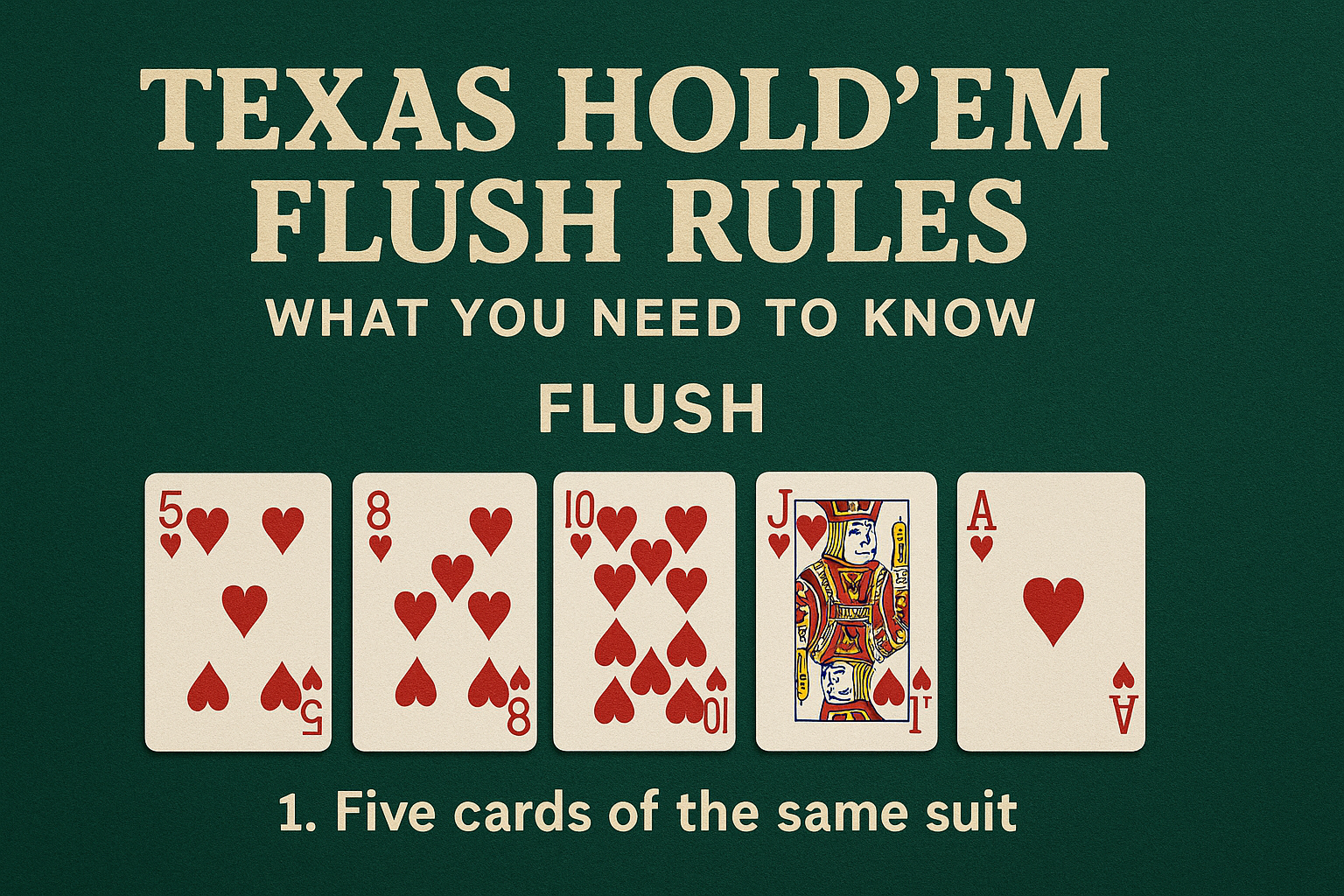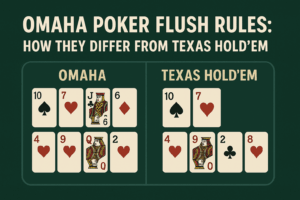Texas Hold’em is one of the most popular variants of poker in the world, known for its strategic depth and exciting gameplay. Among the various hand combinations in this game, the flush is one of the most misunderstood by beginners. A flush can win big pots, but only if the player understands the rules associated with it. To play competitively, knowing the exact texas holdem poker flush rules is critical.
A flush occurs when a player has five cards of the same suit, regardless of their numerical sequence. In a game with community cards, such as Texas Hold’em, this can be achieved through a combination of hole cards and the cards revealed on the board. However, the strength of a flush can vary widely, especially when multiple players hit a flush in the same hand.
How a Flush Is Formed in Texas Hold’em
In Texas Hold’em, each player receives two private cards (hole cards), and five community cards are dealt in three stages: the flop, turn, and river. A flush is created by using any combination of five cards of the same suit from those seven cards.
For example, a player might hold two hearts, and if three more hearts appear on the board, they complete a flush. It’s important to note that only the best five cards are considered when determining the strength of the flush. If six or even seven cards of the same suit are present between a player’s hand and the board, only the highest-ranking five will be used to define the hand.
Understanding Texas Hold’em Poker Flush Rules
The basic rule of flushes in Texas Hold’em is simple: five cards of the same suit create a flush. But the real complexity begins when more than one player completes a flush. This is where understanding hand strength and high card values becomes essential.
The flush’s strength is determined by comparing the highest card in the flush, followed by the next highest if needed. This ranking continues until one flush is deemed superior. For instance, a player with a king-high flush will beat another player with a queen-high flush. If both players have the same high card, the comparison moves to the second-highest, and so on.
High Card Importance in Flush Showdowns
The concept of high card is central to deciding the winner when two flushes occur. A flush with A♦, J♦, 9♦, 6♦, and 3♦ will always beat a flush with K♦, Q♦, 10♦, 5♦, and 2♦, because the ace is higher than the king. It does not matter that the second flush has more face cards if the top card is lower.
This principle ensures a clear hierarchy of flush hands and is the reason why understanding high card values is vital in Texas Hold’em. A low flush is still a flush, but it can be vulnerable in multi-way pots, especially if opponents are holding higher suited cards.
What Happens in a Tie: Poker Flush Rules Tie Explained
A common question among new players is what happens when two players have a flush of equal strength. According to poker flush rules tie scenarios are resolved by comparing the top five cards that make up each player’s flush.
If both players have the exact same five flush cards, the hand is considered a tie, and the pot is split equally between them. This can happen when the flush is entirely made from community cards, and neither player has a hole card that improves the hand.
For example, if the board shows 2♠, 5♠, 7♠, 9♠, and J♠, and both players do not hold a spade in their hand, then both are playing the same flush from the board. In this case, the tie cannot be broken, and both players share the pot.
However, if even one player has a higher spade in hand, such as the Q♠ or A♠, that player wins the pot because their flush is higher.
Flush Versus Other Hands: How It Ranks
A flush ranks higher than many other hands in poker, including straights, three of a kind, two pair, one pair, and high card. However, it ranks below full houses, four of a kind, straight flushes, and royal flushes.
Knowing where a flush stands in the poker hand hierarchy helps players make informed betting decisions. For instance, a strong flush can be confidently played against a suspected straight, but should be approached cautiously when a full house or straight flush is possible based on the board texture.
Flush Draws and Their Strategic Impact
A flush draw occurs when a player has four cards of the same suit and needs one more to complete a flush. In Texas Hold’em, this is a common situation, particularly on the flop or turn. Playing a flush draw correctly requires understanding of pot odds, implied odds, and reading the strength of your opponents’ hands.
On the flop, you have nine outs to complete your flush if you’re holding two suited cards and see two more on the board. That gives you approximately a 35% chance of hitting the flush by the river. If the pot odds justify the call, pursuing the draw can be a profitable move.
However, players should be cautious not to chase draws without a solid understanding of their potential return on investment. Chasing weak flushes can lead to losing larger pots, especially if an opponent completes a higher flush or a full house.
Position and Betting When Holding a Flush
Position plays a crucial role in how you should play a flush. When in a late position and holding a completed flush, players often have the advantage of observing how others act before making their decision. This can lead to more strategic value bets or even trapping opponents who are drawing or holding weaker hands.
In early positions, it’s often safer to play the flush with a moderate betting approach, especially if the board is paired or shows potential straight flush combinations. A reckless bet can give away information or even cause you to be reraised by stronger hands.
It’s also worth noting that slow-playing a strong flush can sometimes backfire if the board becomes dangerous or if your opponent has drawing potential for a higher flush.
How to Identify the Nut Flush
The “nut flush” refers to the highest possible flush that can be made with the available board. For example, if the board shows four clubs and you hold the ace of clubs, you have the nut flush. This is the best possible flush in that particular hand.
Identifying the nut flush is critical in deep-stacked cash games and tournaments, where large pots are more frequent. Knowing whether you hold the absolute best hand can influence how you extract value from your opponents or how you defend against aggressive betting.
Being aware of potential nut flush situations also helps in avoiding traps, especially when the board includes four suited cards and you don’t hold the highest one.
Using Flushes to Your Advantage in Bluffing
Flushes are not only useful when completed—they are also powerful bluffing tools. Representing a flush when the board allows it can force folds from players holding weaker hands. This tactic is more effective against cautious or tight opponents.
However, successful bluffing requires a deep understanding of betting patterns and player behavior. Overusing the flush bluff or attempting it against highly observant players can lead to losses. Bluffing should always be executed with a backup plan or at least some outs to a real hand.
Common Mistakes When Playing Flushes
One of the most common mistakes beginners make is assuming that any flush is unbeatable. This leads to overcommitting to the pot without considering the possibility of a higher flush or full house on the board.
Another frequent error is failing to identify when their flush is not the best possible hand. Players holding a low flush often misread the strength of their hand, especially when multiple suited cards are on the board.
Failing to manage pot size with medium-strength flushes can also be costly. Smart players use pot control and careful aggression to avoid being trapped by stronger hands.
Conclusion: Mastering Flush Rules in Texas Hold’em
Understanding texas holdem poker flush rules is essential for any player looking to improve their game and make profitable decisions. Flushes are strong hands, but they must be played with an awareness of position, board texture, and the possibility of higher flushes or full houses.
By learning how poker flush rules tie scenarios work, you can avoid unnecessary losses and make strategic choices when a showdown occurs. Whether you’re completing a flush, chasing one, or just reading your opponents’ behavior, mastering this part of poker strategy will elevate your game.
For more in-depth information about hand rankings and Texas Hold’em gameplay, you can visit this comprehensive poker rules guide.





